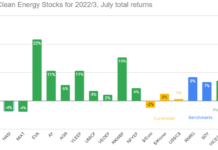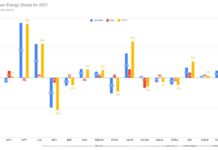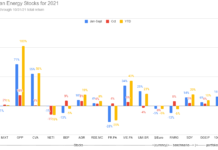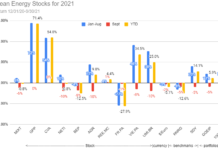Tom Konrad CFA
My clean energy portfolio outperformed again in 2011, but it was a Pyrrhic victory.
Without a doubt, 2011 was a horrible year for Clean Energy stocks, nearly as bad as 2008. The difference was that, in 2008, the entire stock market was crushed, while this year, the broad market ended with only modest declines compared to clean energy stocks.
Based on 2010 and 2011 closing prices, the broad market (as measured by the performance of the Russell 2000 index), was down 10%, while clean energy stocks were down 52%, as measured by the most widely held clean energy ETF, the Powershares Wilderhill Clean Energy ETF (PBW), which I use as a benchmark for the sector. For the fourth year running since I began publishing an annual list of picks, my portfolio again beat my clean energy benchmark, but only because of the miserable performance of PBW. The portfolio as a whole lost 48% after taking into account the effect of dividends. (My portfolio exceeded its benchmark by 12% in 2008, 45% in 2009, and 10% in 2010.) You can find the original article introducing 2011’s clean energy picks here.
What Happened?
I attribute my superior performance in previous years to better sub-sector selection. I generally avoid solar stocks because I have long felt that the solar sector was too popular among people who should know better and too competitive for companies to retain consistent long term margins. Declining solar manufacturing margins arrived with a vengeance in 2011, causing an implosion of solar stock prices, including a couple high-profile bankruptcies.
Energy Efficiency stocks are usually central to my portfolios, since energy efficiency has better economics that other energy technologies (including fossil fuels), although this year I chose to include two demand-response stocks EnerNOC (ENOC) and Comverge (COMV) among the energy efficiency picks and got badly burned, as demand-response seems to be becoming commoditized as well.
Despite the fact that I managed to squeak out a win over PBW, I consider 2011 my worst year to date. Not only did I make the inauspicious choice to bet on demand response, but I also picked two geothermal developers, in the expectation that 2011 would be a good year for geothermal stocks. In fact, not only did geothermal stocks fall even further out of favor in 2011, but both of my picks suffered from nasty surprises early in the year, with Ram Power (RAMPF.PK) reporting large cost overruns in the company’s flagship San Jacinto-Tizate project in Nicaragua, followed by the resignation of the company’s CEO Hezy Ram. Ram later told me that he left over “Irreconcilable differences with the board and controlling shareholders, about the future course of the company and how to get there.”
The news at Nevada Geothermal Power (NGPLF.OB) was even worse. In May, the company announced a power production shortfall and forecast a gradual temperature (and output) decline at their flagship Faulkner 1 geothermal plant at Blue Mountain. According to Nevada Geothermal CEO Brian Fairbank in a personal conversation, the problem was that fractured rock at Blue Mountain allows water from reinjection wells to travel much more quickly than anticipated to the production wells, which has the effect of cooling the produced water over time.
Bad news for specific stocks did not stop with these. In April, American Superconductor, now renamed AMSC (AMSC) admitted that their major customer had refused shipments and had not paid for some previous shipments. As details emerged, the news only got worse. Sinovel had been helping to set up a Chinese supplier whose products competed with AMSC’s, with some of the new rival’s technology stolen from AMSC by a former employee. AMSC is now pursuing Sinovel in Chinese courts, but Chinese courts are not known for their diligence in the protection of international intellectual property.
For stock-by-stock performance, see the chart and table below:

| Q1 change | Q1 div | Q2 change | Q2 div | Q3 change | Q3 div | Q4 change | Q4 div | Total Return | |
| WFIFF | 7% | 0.9% | -12% | 0.9% | -29% | 0.9% | -9% | 1.0% | -39% |
| COMV | -36% | -22% | -2% | -12% | -72% | ||||
| ENOC | -19% | -15% | -19% | 10% | -44% | ||||
| CVTPF | 10% | -17% | -26% | -8% | -41% | ||||
| TLVT/NFYEF | 9% | 41% | -47% | 5.5% | -7% | 3.9% | 6% | ||
| PCH | 20% | 1.6% | -10% | 1.6% | -30% | 1.6% | -1% | 1.0% | -16% |
| NGLPF | -11% | -66% | -9% | -4% | -89% | ||||
| RAMPF | -35% | -43% | -4% | 4% | -78% | ||||
| AMSC | -18% | -51% | -15% | -1% | -84% | ||||
| VE | 4% | -1% | 5.8% | -55% | -12% | -58% | |||
| Portfolio | -6% | 0.2% | -20% | 0.8% | -19% | 0.8% | -5% | 0.6% | -48% |
| PBW | 1% | -14% | -35% | -4% | -52% | ||||
| Russell 2K | 4% | 1% | -27% | 12% | -10% |
Outlook for 2012
With fully 30% of the companies in my list suffering from unanticipated bad news, I’m a bit shocked that the portfolio still managed to beat its benchmark. But with my portfolio down by almost half, this is a victory of the “Win the battle, lose the war” variety, and not one I care to repeat. Fortunatel
y, I don’t think I’ll have to.
With so many clean energy stocks having fallen so far, I have been finding stocks which I consider good values for much of the last 6 months. While 2011 felt a lot like 2008, I think 2012 has the potential to be a lot more like 2009 than any other year since I started this series. In 2009, my picks were up 57%, while PBW was up 27%.
Expect to see my new list for 2012 in the next few days.
DISCLOSURE: Long VE, RAMPF, NFYEF, WFIFF, CVTPF, and calls on AMSC.
DISCLAIMER: The information and trades provided here are for informational purposes only and are not a solicitation to buy or sell any of these securities. Investing involves substantial risk and you should evaluate your own risk levels before you make any investment. Past results are not an indication of future performance. Please take the time to read the full disclaimer here.







